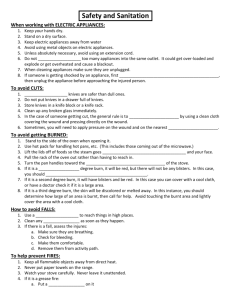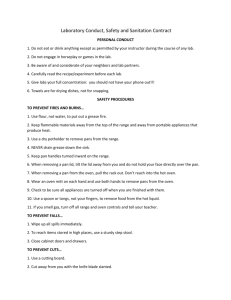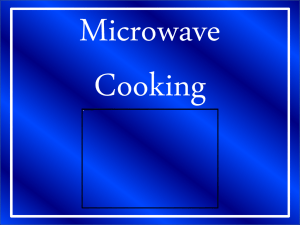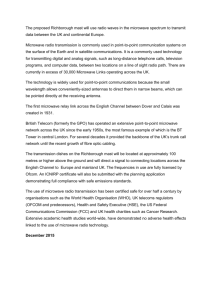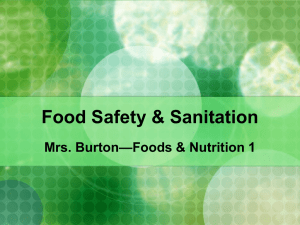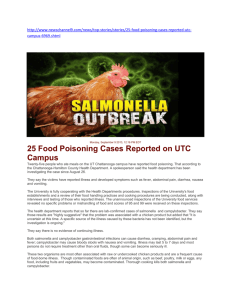What is a food borne illness?
advertisement
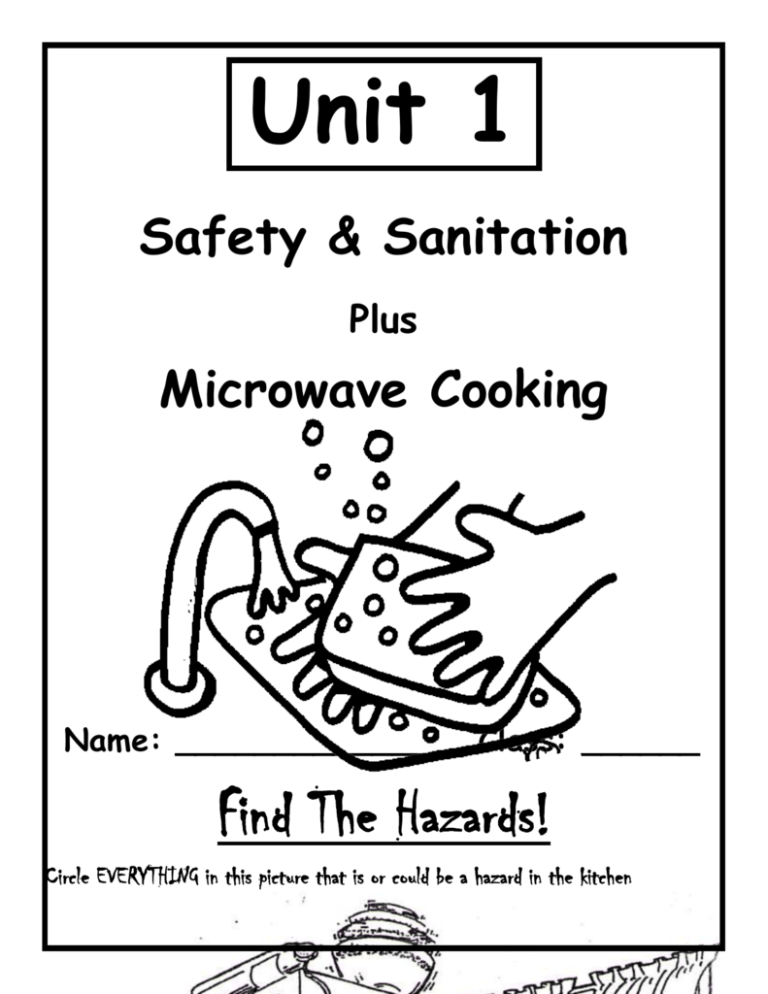
Unit 1 Safety & Sanitation Plus Microwave Cooking Name: ______________ Class: ______ Find The Hazards! Circle EVERYTHING in this picture that is or could be a hazard in the kitchen Food Borne Illness 1. What is a food borne illness? An illness caused by eating food contaminated with ________________ 2. How common is Food Borne Illness? _______________ common! There are millions of cases each year. 3. What are some general symptoms of Food Borne Illness? ____________________ • _______________________ ____________________ • _______________________ ____________________ • _______________________ ____________________ • _______________________ 4. How serious is Food Borne Illness? It can be very mild or potentially ___________ (_____________!) 5. What four things do bacteria need to be able to grow? _______________ _______________ _______________ _______________ 6. What does a virus need to be able to grow? A ______________ (something to live and multiply in) 7. How are most Food Borne Illnesses spread? When food is left in the _____________________________ for too long Unsafe food ________________ practices 8. How can most food borne illnesses be prevented? Using ___________ food handling practices Keeping food _________ of the temperature danger zone 9. What is the temperature danger zone? ANY temperature BETWEEN ______________ and ______________ SALMONELLA A. Found In: ___________________________________________ Fish Unpasteurized Milk B. Symptoms: Headaches • Cramps Diarrhea • Vomiting E. COLI A. Found In: ____________________________________________ Unpasteurized Milk Improperly handled or stored foods Contaminated Water B. Symptoms: Sever bloody diarrhea • Fever Cramps STAPHYLOCOCCUS (STAPH) A. Found In: _____________________________________________ Spoiled starchy foods (potatoes, cake fillings, etc.) B. Symptoms: Nausea • Diarrhea Vomiting • Severe Cramping BOTULISM A. Found In: ______________________________________________ Soil Contaminated Water B. Symptoms: Weakness • Difficulty Breathing Constipation • Impaired Speech Double Vision HEPATITIS A A. Found In: _______________________________________________ Improper hand washing after using the restroom B. Symptoms: Flu-like symptoms • Severe Diarrhea Vomiting Based on this information, list TEN ways to prevent the spread of a food borne illness: 1. _____When in Doubt, Throw It Out!_____________________ 2. __________________________________________________ 3. __________________________________________________ 4. __________________________________________________ 5. __________________________________________________ 6. __________________________________________________ 7. __________________________________________________ 8. __________________________________________________ 9. __________________________________________________ 10._________________________________________________ Microwave Cooking 1. Microwaves are ATTRACTED to: a. ____________ b. ____________ c. _____________ 2. Microwaves are REPELLED by: a. ____________ 3. What materials or containers are microwave safe? a. ____________ b. ____________ c. ______________ 4. What part of the microwave oven generates the microwaves? 5. Which container cooks more evenly-Round or Square? WHY? 6. What is standing time and WHY is it important? 7. Why should you stir or rotate food when microwave cooking? 8. What part of the microwave will rotate the food while it is cooking? 9. Why a. b. c. is it best to cover most foods when microwave cooking? ______________________________________ ______________________________________ ______________________________________ 10. Why do foods NOT brown in the microwave? 11. How can you prevent burns when microwave cooking? a. ______________________________________ b. ______________________________________ c. ______________________________________ Safety Guidelines and Safe Work Habits The kitchen is one of the most dangerous places in your house. There will always be some accidents, but there are certain practices and precautions that can help you avoid accidents. When working with ELECTRIC APPLIANCES: 1. Keep your ________________ dry. 2. 3. 4. 5. Stand on a ______________ surface. Keep electric appliances away from ________________. Avoid using ________________ objects on electric appliances. Unless absolutely necessary, avoid using an _____________________, make sure the appliance cord as well as any extra parts are in good condition. 6. Do not ____________ too many appliances into the same outlet. It could get over-loaded and _______________, or get overheated and cause a blackout. 7. When cleaning appliances make sure they are ____________________. 8. If someone is getting shocked by an appliance, first ____________________ _______________, then unplug the appliance before approaching the injured person. To avoid CUTS: 1. 2. 3. 4. Use ________________ knives rather than dull ones. Do not put knives in a _____________________ full of knives. Store knives in a ___________________ or a knife _________________. Clean up any broken glass ____________________; and wrap your hand in a ______________________________ before touching the broken glass. 5. In the case of someone getting cut, the general rule is to _________ _________________ by using a clean cloth covering the wound and pressing directly on the wound. 6. Sometimes, you will need to apply pressure on the wound and on the nearest _______________________________. To avoid getting BURNED: 1. Stand to the side of the oven when ____________________ it. 2. Use ___________________ for handling hot pans, etc. (This includes those coming out of the microwave.) 3. Lift the lids off of foods so the __________ goes _______________________. 4. Pull the ___________ of the oven __________ rather than having to reach in. 5. In the case of a burn, you will need to determine the ______________ of the burn. 6. If it is a _____________ degree burn, it will be red, but there will not be any blisters. In this case, you should run it under _________________________. 7. If it is a ______________ degree burn, it will have blisters and be red. In this case you can cover with a _________________, or have a doctor check it if it is a large area. 8. If it is a ___________ degree burn, the skin will be discolored or __________ ___________. In this instance, you should determine how large of an area is burnt, then call for _____________. Avoid touching the burnt area and lightly cover the area with a cool cloth. How to avoid FALLS: 1. Use a ___________________ to reach things in high places. 2. Clean any ________________ as soon as they happen. 3. If there is a fall, assess the injures: a. Make sure they are breathing. b. Check for bleeding. c. Make them comfortable. d. Remove them from activity path. To help prevent FIRES: 1. 2. 3. 4. 5. Keep all ________________________________ away from direct heat. Never put _____________________ on the range. Watch your _________________ carefully. In case of a fire, you need to treat it according to ______________________. If it is a grease fire: a. Put a ______________ on it b. Pour ___________________ on it c. Use a fire __________________________ 6. Do _________ ever use: a. Water b. Sugar c. Flour CLEANING and CLEANING SUPPLIES: 1. You should keep all __________________ and ___________________ clean. 2. Wash the counter with a _____________________ before you begin to cook. 3. Clean ____________________. It will keep the area clean and will make the clean-up much easier. 4. To properly wash dishes: a. Throw away or rinse any food left on dishes b. Fill one sink with hot soapy water c. Fill the other sink with plain hot water d. Wash dishes in soapy water, then rise all soap away in the plain hot water e. Place dishes in dish rack or dry with a clean towel 5. When you are doing the final clean-up, you should wash the dishes in the following order: a. ____________________________ b. ____________________________ c. ____________________________ d. ____________________________ e. ____________________________ To prevent POISIONING and CONTAMINATION by cleaning supplies: 1. Keep all chemicals ________________ from the food and store them in a _____________________________ than you store your food. 2. Keep supplies in their ______________________________ and make sure they are labeled with their contents, what they are there for, and how to use them. 3. The safest rule as far as mixing cleaning supplies is:__________________! 4. There are combinations that are extremely dangerous like _______________ and __________________. 5. These two combinations produce a ________________________. Sanitation Study Guide Food–borne illness results from eating contaminated food containing poisonous TOXINS. The general conditions for bacterial growth in food are FOOD, MOISTURE and WARMTH. Below are several things you can do to prevent bacterial growth in your food. Section 1 – Personal: 1. Wash your hands with soap and warm water for at least _______________. 2. Wash your hands after: a. _____________________________________________________ b. _____________________________________________________ c. _____________________________________________________ 3. Wear __________ if you have a cut or any open sore on your hands. 4. Tie back or cover your _________ before working with food. 5. Change your _______ if it is dirty; bacteria on it could contaminate food. 6. When tasting food, use a testing spoon only ____________! SECTION 1 WORD BANK Gloves Sneezing/coughing/touching hair or face Using the restroom Once Apron Hair 20 Seconds Before and after handling raw meat Section 2 – Work Surfaces/Dishes: 1. Disinfect work surfaces with a _____________________ disinfectant. 2. In order to reduce pests or insects: a. Clean–up ________________________________ b. Dispose of ______________ properly c. Keep _______________________________ in airtight containers 3. Use _____________________________________ cutting boards, not wooden ones. 4. Never place food on a plate or cutting board that has held ____________. 5. Always wash hands, cutting boards, etc., with ____________________ after coming in contact with raw meat, poultry, eggs or seafood. 6. Wash dishes in the following order: a. ___________________________ b. ___________________________ c. ___________________________ d. ___________________________ e. ___________________________ SECTION 2 WORD BANK Glassware Commercial Staple Ingredients Kitchen Tools Garbage Plastic or Non–porous Pots and Pans Dinnerware Hot Soap Water Utensils Crumbs and Spills Raw Meat Section 3 – Temperature Zones/Cooking: 1. 2. 3. 4. 5. Use a clean thermometer to check the ___________ temperature of foods. Ground beef must be cooked to ______; never eat it if it is still ________! Cook eggs until the yolks are _________. Don’t use recipes where eggs remain ________ or ________________ cooked. The “Temperature Danger Zone” for food–borne bacteria is between __________ F. and ___________ F. 6. Your freezer temperature should be _______ F. to keep foods frozen. SECTION 3 WORD BANK 40º Firm Pink 160º Internal Partially 0º 140º Raw Section 4 – Cooling and Reheating: 1. Keep hot foods ___________ and cold foods _____________. 2. Foods should not be in the “Temperature Danger Zone” for more than ______________; refrigerate or freeze as soon as possible after eating. 3. Place leftovers in _______________ containers and refrigerate immediately. 4. Air in the refrigerator and freezer needs to ________________ in order to keep things cool enough to be safe, so leave some space around the containers in your refrigerator as they cool. 5. When in doubt, _______________________________! 6. The number one cause of food–borne illness is due to improper _______________ of food. SECTION 4 WORD BANK 2 Hours Storage Cold Shallow Hot Throw It Out! Circulate Section 5 – Thawing: 1. The safest way to thaw food is in the __________________; NEVER defrost foods at ______________ temperature. 2. If you thaw something under cold, running water or in the microwave, cook it __________________________. 3. You can safely thaw food in three ways. They are: a. In the refrigerator for ______________________ b. In a sink of _________________________ (changing water at least every 30 minutes) c. In the ________________________ SECTION 5 WORD BANK Immediately Microwave Room Refrigerator 2 to 3 Days Cold Running Water
